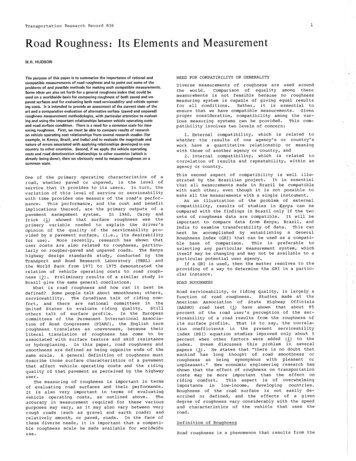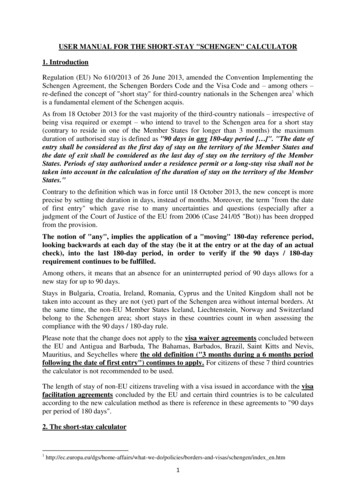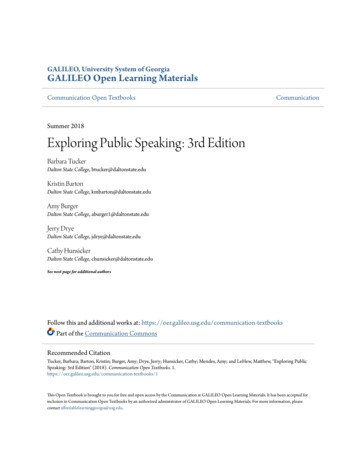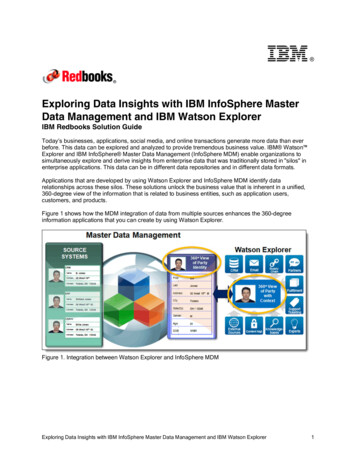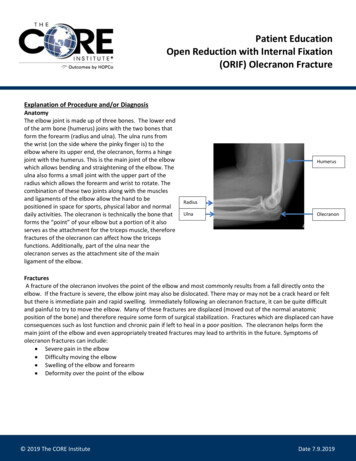
Transcription
“How was your stay?”: Exploring the Use of Robots forGathering Customer Feedback in the Hospitality IndustryMichael Jae-Yoon Chung and Maya CakmakAbstract—This paper presents four exploratory studies of the potentialuse of robots for gathering customer feedback in the hospitalityindustry. To account for the viewpoints of both hotels andguests, we administered need finding interviews at five hotelsand an online survey concerning hotel guest experiences with60 participants. We then conducted the two deployment studiesbased on deploying software prototypes for Savioke Relayrobots we designed to collect customer feedback: (i) a hoteldeployment study (three hotels over three months) to explorethe feasibility of robot use for gathering customer feedbackas well as issues such deployment might pose and (ii) a hotelkitchen deployment study (at Savioke headquarters over threeweeks) to explore the role of different robot behaviors (mobilityand social attributes) in gathering feedback and understand thecustomers’ thought process in the context that they experience aservice. We found that hotels want to collect customer feedbackin real-time to disseminate positive feedback immediately andto respond to unhappy customers while they are still on-site.Guests want to inform the hotel staff about their experienceswithout compromising their convenience and privacy. We alsofound that the robot users, e.g. hotel staff, use their domainknowledge to increase the response rate to customer feedbacksurveys at the hotels. Finally, environmental factors, such asrobot’s location in the building influenced customer responserates more than altering the behaviors of the robot collectingthe feedback.I. I NTRODUCTIONGathering customer feedback is a critical component ofthe hospitality industry. Hotels have long amassed guestfeedback to measure customer satisfaction and loyalty as wellas staff performance. The collected feedback helps hotels tomonitor service quality, make necessary improvements, andultimately stay ahead of the competition [1].We believe service robots can be an effective medium toelicit and gather guest feedback in hotels since they canserve as neutral liaisons between hotels and guests. Therobots also draw people’s attention in public spaces [2]–[6],and their interactive behaviors can be precisely controlledto enforce hotel brand standards or elicit certain emotionalresponses [7].Finding a novel real-world use case for service robotsis not trivial. Deploying robots in workplaces may requirestructural and procedural changes in workplace design anduse [8], consequences that are difficult to foresee and costlyto discover post-deployments. In addition, it is difficult togather quality feedback from potential users in up-frontThe authors are withUniversity of Washington,Computer Science & Engineering,Seattle, WA 98195-2350 {mjyc,mcakmak}@cs.washington.eduFig. 1. (Left) The Relay robot running the breakfast survey behaviorat the P1’s hotel. (Right) The robot asking for employee feedback aboutthe provided meal at the Savioke headquarters. The robot briefly stoppednavigating to respond to the employee.research sessions because most people lack firsthand experiences with robots in their workplace [9].With these challenges in mind, we present four studies exploring the customer feedback collection use case for robotsin the hospitality industry that feature the Savioke Relay, acommercial service robot. We discuss the overall approachin Sec. III and share our experiences and learned lessonsas findings and design implications from each study in thesubsequent sections (Sec. IV, Sec. V, Sec. VI, Sec. VII).II. R ELATED W ORKOur work is part of the research being done in the field ofhuman-robot interaction (HRI), which focuses on designingand evaluating real-world robot applications.Over the last decade, HRI researchers have employedproduct design methods such as need finding and participatory design to understand users’ needs and related constraintsand requirements for domains of interests, such as homeorganization [10] and guiding visitors in tourist sites [11],airports [12], and office buildings [13]. Findings from thesestudies have been abstracted into themes [12], [13], frameworks [10], and visual maps of user experiences [11] andused to derive design recommendations. While such researchwork presents insightful recommendations, we believe it isalso critical to evaluate a potential application early in thedeployment process and in real-world settings (for example,via prototyping) to learn critical design and implementationlessons soon as possible.A body of HRI work evaluates robotic systems in thewild [2]–[4], [14]–[17]. Researchers in this domain ask questions concerning feasibility and performance of the proposed
systems, e.g., “Can the robotic system successfully performthe given task?” and “How well does it work?” This researchattempts to understand why the proposed systems work (ordo not work) and to identify factors influencing robot usage.For example, researchers verified the feasibility of deployingfully autonomous robots as guides in public places [2], [14],[15], a walking group assistants in a care site [17], andas scouts in an office building [16]. They also investigatedpotential benefits, such as enhancing the motivation of olderadults [17]. Compared to these studies, our work puts moreemphasis on understanding the requirements and opinionsof multiple stakeholders of our proposed use case beforedeveloping it.Our work is also related to work that applies a designapproach when developing a service robot application. Threeprominent examples are Snackbot [18], a delivery robot in anoffice building; TOOMAS [19], a shopping guide robot in ahome improvement store; and Sacarino [20], a bellboy robotin a hotel. The research teams for these projects employeddesign processes that involved multiple phases of prototypingwith potential users in target environments to get continuousfeedback during development. Recently, researchers proposed adapting a lean UX design approach from the startupfield for identifying a commercial social robot applicationand applied the proposed method to rapidly prototyping anassistant robot in Sydney International Airport [21]. Likethese work, our research also emphasizes the importance ofthe users and the context of a robot application. However,we focus on a much less explored domain: a guest feedbackcollection use case involving a non-anthropomorphic robotin hotel environments.III. A PPROACHThis paper explores the use of robots for gathering customer feedback in hotels. We address the following researchquestions: Can we use robots to gather feedback from hotel guests? How should we design robotic systems to gather bettercustomer feedback?The answer to the first question depends on the context inwhich robots interact with customers. Hence, it is importantto understand the physical and situational context as wellas customer opinions. It is also important to understand theneeds of service industry workers and their current practicesfor gathering customer feedback. Finally, it is critical totackle these questions through field deployments to capturethe context in which the customer experiences the service anddecides whether and how to respond to a robot’s solicitationfor feedback. To that end, our research focused on theSavioke Relay robot (Sec. III-A), which were deployed inapproximately 70 hotels in January 2018.1We conducted the following four studies:1) Need finding interviews with hotel management (n 5)at five hotels that already used a Relay robot for guest1 me-employees-at-a-las-vegas-hotelroom delivery. We explored the current practices hotelsuse to gather customer feedback and the contexts inwhich the robot could gather feedback (Sec. IV).2) An online survey with varying-frequency hotel customers (n 60). We explored guests’ perceptions of theRelay room delivery robot and their willingness to respond to the robot in different situations cs respondingto other feedback methods (Sec. V).3) Passive observations and follow-up interviews (n 5)at three of the five hotels in 1). We deployed theprototypes of robot-based customer feedback applications for 3-4 months explored the value that the robotadded, interaction patterns with the robot, and realworld challenges in gathering feedback from customerswith robots (Sec. VI).4) Passive observations, follow-up questionnaires, andanalysis of measurements in a three-week deploymentat a kitchen area of the Savioke headquarters. Weexplored the role of different robot behaviors (mobilityand social attributes) in gathering feedback and identified design constraints (Sec. VII).A. The Relay RobotSavioke Relay2 is an autonomous mobile robot that delivers small items from the front desk to guest rooms inhotels. The robot is approximately three feet tall and weighs100 pounds, has a lockable interior bin, and displays atouchscreen mounted facing forward.The default behavior of the robot is as follows. The robotstays in its docking station and charges its battery when notin use. Upon receiving a delivery request, the front desk clerkloads the robot’s bin and sends it to the specified location.The robot travels to the guest’s room by traversing hallways,doorways, and elevators while avoiding obstacles and people.When it reaches the destination room, it phones the room tonotify the guest of its presence, and it opens its lid whenthe guest opens the room door. Once the guest retrieves theitem, it interacts with the guest to confirm the pickup andthen returns to its docking station. Hotel staff interacts withRelay through a web interface to send a delivery, monitor therobot’s status and location, and download a delivery history.Although the Relay robot was designed for a specificapplication, it can be considered a general-purpose mobilerobot that uses parts (e.g., a mobile base and touchscreen)common to other autonomous indoor robots, such as thosefrom Vecna, Cobalt Robotics, and Fellow Robots.3IV. N EED F INDING I NTERVIEWS AT H OTELSIn 2016, we conducted need finding interviews with fiveemployees who held administrative staff jobs at five hotelsthat had been using a Relay robot [22]. The interviews tooka place in the participants’ hotels and were structured tolearn: (i) current practices for collecting guest feedback, (ii)opinions on the idea of gathering feedback with the robot,and (iii) guest experiences with using the robot at their hotels.2 www.savioke.com3 www.vecna.com,www.cobaltrobotics.com, www.fellowrobots.com
Fig. 2. (Left, Middle) Pictures of the kiosk and the Relay robot used inthe online survey to illustrate Kiosk and Robot FD. (Right) A screenshotfrom the video that demonstrates room delivery to convey Robot RM.We learned that the hotels actively collect guest feedbackand heavily rely on traditional means to collect data, suchas post-stay email surveys or collecting data from onlineforums such as TripAdvisor.4 The collected data were mostfrequently used to prevent or recover dissatisfied customers.We also found that the day of the week, the season and guestdemographics most affected the robot usage the most. Hotelswere interested in using the Relay robot to solicit guestfeedback in a lobby or to ask customer satisfaction questionsafter a room service delivery. After collecting feedback,hotels suggested that the Relay robot could alert the staffmembers about issues or resolve problems as they occur.We summarize our findings and design recommendationsfrom [22] below.Based on our findings, we propose the following designrecommendations. Overall, robots should play a role in helping hotels widely disseminate positive customer feedback.Robots should take advantage of being in the context ofthe service to encourage customers to easily express theiropinions in the moment and on the property. They should bedesigned to make guests feel more comfortable giving negative feedback. Robots should always respond to customerfeedback. By default, interactions for gathering feedbackshould be short and, if possible, entertaining to accommodatethe short attention spans of modern customers. Robots couldleverage their status as novelty items to engage customers andencourage them to respond to questions. Ultimately, robotsshould adjust their strategies for eliciting engagements andinteracting with customers based on the types of customers.V. O NLINE G UEST S CENARIO S URVEYViewpoints of guests are important to hotels as well asto the robotics company providing the service. Hence, weconducted an online survey that explored potential guests’attitudes and motivations towards robot-based feedback solicitations compared to other solicitations.A. Survey DesignTo help participants contextualize the decision about responding to different kinds of customer feedback solicitations, we provided a motivating scenario. We chose one negative and one positive guest experience scenario adapted fromthe scenarios5 commonly used in hospitality research [23].4 https://www.tripadvisor.com/5 Formore details, see Appendix A. in the Supplementary Materialsavailable at https://goo.gl/xz1xk8.Each participant read one of the two scenarios. We instructedparticipants to assume the situation described in the scenariohad just happened to them. We asked them how likely theywould be to respond to each of the following feedbacksolicitations (1: Extremely unlikely to respond; 5: Extremelylikely to respond): Email: You received an online survey after you left thehotel. Kiosk: You noticed a kiosk near the front desk whichsays “How is your stay?” Robot Front Desk (FD): You noticed a robot near thefront desk which says “How is your stay?” Robot Room (RM): You ordered a snack from the frontdesk and a robot delivered the snack to your room. Afterhanding off the snack, the robot asks “How is yourstay?”We included an optional open-ended question asking for anexplanation of each response. For Kiosk, Robot FD, andRobot RM, we included explanatory images and a video togive participants an accurate sense of what the kiosk androbot would look like (Fig. 2). Note that the four solicitationmethods were selected based on Savioke’s and their customerhotels’ business interests.B. ParticipantsParticipants were recruited through Amazon MechanicalTurk. After agreeing to participate, online participants weredirected to the single-page form that contained the scenarioand the four questions about the four feedback alternatives.To control for quality of responses, we did not allow aperson to participate in our survey more than once andrejected people who incorrectly answered the question usedto identify those who randomly selected answers. We offered 0.01 for participation and continued recruiting until we had30 responses for each scenario. A total of 60 people (22M, 38 F) responded in less than 2 weeks. Their age groupsdistributions were: 10% in 19-24, 30% in 25-34, 30% in 3544, 30% in 45-54, 16.67% in 45-54, 10% in 55-64, 3.33% in65-74. Respondents’ answers to the question regarding thefrequency of staying at a hotel in any given year ranged from1 to 20, with a median of 2 times a year.C. FindingsThe means and standard deviations of the responses acrossthe four solicitations were: M 3.58 & SD 1.43 (Email);M 3.38 & SD 1.58 (Robot RM); M 3.25 & SD 1.67(Kiosk); and, M 2.68 & SD 1.69 (Robot FD). The samestatistics across the two scenarios were: M 3.22 & SD 1.52 (Positive); and, M 3.23 & SD 1.72 (Negative). Fig. 3shows the distribution of responses for each feedback solicitation method in each scenario. We conducted open codingfor the open-ended question responses. We summarize ourfindings below.1) Factors Influencing Guests’ Willingness to Respond:The most frequently mentioned reason for responding to asolicitation method was for participants to share hotel experiences (e.g., “I would want the hotel to know that my room
Negative ScenarioScenario TypePositive ScenarioConditionMeanEmail3.73Kiosk3.73Robot FD2.33Robot RM3.13Email3.43Kiosk2.77Robot FD3.03Robot RM3.63113%27%23%210%27%13%30%27%13%017% 7%23%20%13% %23%17%23%1517%27%40%202530Fig. 3. The distribution of responses for different feedback solicitations inpositive and negative guest experience scenarios (1: Extremely unlikely torespond; 5: Extremely likely to respond).negative scenario most commonly questioned the possibilityof the presented scenario, for example, by commenting Ifthey had enough money for a robot, they would have enoughmoney for a cleaning staff to do a good job.3) Perception of the Robot-based Solicitations: Regardless of the scenario type, participants mentioned similar reasons for liking or disliking the two robot-based solicitations.When participants were willing to respond, the reasons theyoffered included the novelty effect (e.g., “I will fill out ofcuriosity.”), the entertainment value of the robot (e.g., “Therobot would interest me and be a fun addition to my stay.”),and the feeling of obligation (e.g., “Because the robot needsa response.”). When they were not willing to respond, theymentioned that they disliked the robot (e.g., “A feedbackrobot? That’s just weird; the world isn’t ready for that.”),did not trust the robot (e.g., “I wouldn’t trust the robot.”),or envisioned a potential difficulty using the robot (e.g., “Noclue how to interact with it.”).D. Design Implicationswas unacceptable.”). The second most mentioned reason wasconvenience. This was also the main reason why Email andRobot RM were rated highly. For example, a participantmentioned, “If I’m already interacting with the robot, I mayas well answer the question.” In fact, inconvenience was thetop reason for participants’ unwillingness to respond to asolicitation method.Some participants had privacy concerns about using theKiosk and Robot FD, e.g., “Less likely, but I’d feel thestaff might be watching over my shoulder.” They mentionedthat they liked the Email and Robot RM methods becauseof increased privacy, e.g., “I would respond because it isstill kind of private and (the robot is) not out in the busylobby.” Given our findings from the need finding interviews(Sec. IV), we noticed an understandable conflict betweenhotels and guests: hotels want more data from guests, butguests value privacy want it to be respected.2) Influence of the Scenario Type: The influence of thescenario type varied across the four solicitations. When theparticipants read the positive scenario and were presentedwith Email or Kiosk, they were not enthusiastic aboutinforming the hotels (Email: p 0.001, Kiosk: p 0.00001;one-tailed, paired t-test); more than half said they would beunlikely to respond (i.e., responded with 3) because theywould not have the time or did not want to further engagewith the hotel. In contrast, more than half of the participantswho read the negative scenario and were presented withEmail, Kiosk, or Robot RM would inform the hotel abouttheir stay (responded with 3).The participants were more enthusiastic about respondingto the two methods involving robots when they read thepositive scenario than when they read the negative one (bothRobot FD and Robot: RM p 0.0001; one-tailed, pairedt-test). Some participants would be likely to respond to therobot (i.e., responded with 3) predicted that interactingwith it would be pleasant and would make their experienceat the hotel unique. In contrast, the participants who read theThe process of providing feedback to the robot shouldbe as convenient as possible for the guest, for example, bykeeping survey questions short or asking a question at theend of a different interaction to allow the guest to ignore thequestion. Robots should respect the privacy of guests evenat the cost of losing data they can provide to the hotels sincethe goal of both hotels and robotics companies is to satisfycustomers. For example, robots should collect guest feedbackin private settings and restrict using sounds or movementsthat could reveal guest responses in open spaces.VI. H OTEL D EPLOYMENTSThree interviewees–P1, P2, and P56 –from the need findinginterviews (Sec. IV) were interested in using a robot-basedfeedback solicitation at their (different) hotels. This gave usthe opportunity to test our idea in the field and thereby betterunderstand real-world challenges.A. Breakfast Room SurveyP1 requested that we enable the Relay robot to ask a fewcustomer satisfaction survey questions to the hotel guests inthe breakfast room area. We collaborated with a robot UXdesigner at Savioke to prototype a breakfast room surveyrobot’s behavior and refined it with P1 to meet hotel’s requirements. The prototype behaved as follows. Upon launch,the robot navigated to a predefined location near the entranceof the breakfast room. The robot then stayed in place anddisplayed the question, “Good morning! How was yourbreakfast?” together with a five-star rating response field.When a customer response was detected, it asked the secondquestion, “How is your stay?” and responded on receivingfive stars with a happy facial expression and a dance. If noresponse was received within five minutes, the robot playedwhistle sounds and displayed the two messages, “Hello! I’mRelay, a delivery robot.” and “Need anything? Dial 0 from6 See[22] for descriptions of P1, P2, and P5.
your room and I’ll bring it to you!” in sequence to elicitattention from passing guests.In May 2017, we installed the break room survey behaviorto the Relay robot in P1’s hotel (as shown in Fig. 1 (Left))and instructed all staff members there about how to start andstop the survey behavior and handle the potential problems.While the robot’s status information, such as its locationand remaining battery charge, was available on the webinterface, the hotel staff was not able to see the customerresponse history (due to logistical reasons). However, P1insisted on deploying the breakfast room survey behavior asis to increase utilization of the robot. To gain insight into howthe hotel used the provided survey behavior, we monitoredtheir usage for four months both remotely and through twoon-site visits, on Tuesday and Saturday of the 3rd week ofSeptember 2017, to observe the robot in context. We werenot allowed to talk to guests for logistical reasons.B. Low-Ratings Alert for Guest Room DeliveryP2 and P5 requested that we enable the Relay robot toask customer satisfaction questions after each guest roomdelivery and alert staff members on receiving negative responses from guests. We collaborated with a Savioke robotUX designer and prototyped a feature that adds the “How isyour stay?” star rating question after a delivery confirmationinteraction and sends email alerts on receiving ratings belowthree stars.We provided the low-rating alert feature to both hotelsin June 2017. We configured the feature to send emails tothe staff mailing list and logged the usage of the featurefor four months. On the first week of September 2017, weinterviewed P2 and P5 and one staff person at each hotel.C. FindingsDespite not providing actual feedback from customers,the staff members at P1’s hotel used the breakfast roomsurvey extensively. Over the four months, they used thesurvey every day except for three days post-deployment (123days). On average, the survey ran for 229 minutes, and 43questions were answered per day. On our two visit days,we observed approximately 9 guest-robot interactions on thefirst day and 22 on the second day. The robots receivedresponses to the customer satisfaction question 1707 timesat the P2’s hotel and 709 times at the P5’s hotel during thefour months deployment. Of those, 46 and 17 (2.70% and2.40%), respectively, received less than three stars.1) Values of Robot-Based Guest Feedback Collection:As predicted in the need finding interviews (Sec. IV), P1reported that the robot’s ability to provide unique experiencesto the guests was its most valuable aspect. P1 nonethelessacknowledged the potential benefit of the data collectedby the robot: “Getting a report that shows me the overallscores, that would be great. That way, at least I could trackwhat days people are not happy with.” Regarding the lowratings alert feature, both P5 and P2 were satisfied with thefeature and mentioned they were able to capture 2-3 unhappycustomers per month.2) Hotels Used Their Domain Knowledge: We learnedthat the time and location of running the breakfast surveybehavior were carefully selected by the hotel staff. The robotwas located in front of the breakfast room area, which waslocated right next to the elevator. Hence, the robot was seenby people going in and out of the breakfast room as wellas guests waiting for the elevator; most people noticed therobot immediately or via the whistle sounds it played. Wealso noticed the network effect: whenever a guest startedinteracting with the robot, it raised the attention of theother passing or waiting guests. When we continued ourobservation at P1’s hotel in the afternoons, we observedalmost no activities near the breakfast room.At P2’s hotel, a staff person mentioned they paid extraattention over the weekend because the hotel usually receivesa higher number of complaints while the staff person fromP5 reported that they paid extra attention to input from guestswith a membership.3) Privacy Issues: Due to logistical reasons, our two prototypes did not rigorously follow one of our own guidelines:the robot should respect customer privacy. For example,the robot responded with a whistle sound and a dance onreceiving five stars while surveying in the breakfast area,which allowed the people around the robot to notice whatrating the person had given. In addition, the low ratings alertfeature did not give customers the choice of notifying thefront desk when they responded with less than three stars onthe “How is your stay?” question. We learned that the hotelstook advantage or were unaware of the consequences. Forexample, P1 mentioned that they like to monitor the guestinteracting with the robot to not only to identify unhappycustomers but also to understand the status of the hotel ingeneral by eavesdropping on nearby conversations around therobot. Regarding the low ratings alert, all four intervieweesmentioned that they always followed up with guests torecover potentially unhappy guests. No one considered theguests who do want to be contacted by the hotels.D. Design ImplicationsThe user interface for the robot should be designed toprotect guest privacy. For example, on receiving complaints,the robot should ask whether the guest is comfortable withits informing hotel staff about the complaints. To maintainthe robot’s position as a neutral liaison between hotels andguests; the interface should not reveal the guest’s feedbackif they do not want to inform the hotel. The interface for therobot should support using the hotel users’ domain knowledge, e.g., providing an option to customize the messagesused during survey, schedule survey behavior, or changesurvey location.VII. K ITCHEN D EPLOYMENTAs a final step in our exploration, we wanted to betterunderstand: (i) the impact of the Relay robot’s behavioron eliciting customer feedback, and (ii) the opinions ofcustomers who are experiencing a service. In the hotel
Fig. 4. Finite state machines that implement the three robot behaviors:Baseline, Social, and Mobile.Fig. 5. The layout of the kitchen where the Relay collected feedbackabout meals. Large icons show the poses of the robot in Baseline and Socialbehaviors (gray: breakfasts, blue: lunch). Small connected icons show thewaypoints in Mobile behavior.deployment study (Sec. VI), testing out different robot behaviors at hotels or talking to guests was not an option forlogistical reasons. Therefore, we deployed a survey robot atthe kitchen of Savioke’s headquarters.A. Study DesignWe believe the Relay robot has two key properties that offer competitive advantages when gathering feedback relativeto other feedback modes: mobility to move towards potentialrespondents, and social agency to increase the engagementusing social cues [6]. By varying these properties, we designed the following three behaviors: Baseline was designed to mirror the experience ofusing a kiosk, like the Happy-or-Not Smiley Terminal.7The robot stayed at a predefined location and asked aquestion about the meal using a five-star rating selectionmenu. We removed Relay’s face, i.e., the eyes andspeech bubble shown in Fig. 2, with a white backgroundand did not use any sounds or movements. If a personanswered the question with a rating, the robot respondedby displaying “Thank you” for 5 seconds.Social was designed to make people perceive the Relayrobot as a social agent. While its general behavior wassimilar to that of Baseline, the Social robot used moreanimated messages, including sounds, in-place movements, and LED light patterns. We kept Relay’s face; allmessages were displayed in the robot’s speech bubbleby using facial expressions. When nobody interactedwith the robot for more than five minutes, the robot7 https://www.happy-or-not.comencouraged people to rate their meal with sounds andtexts (i.e., ‘Run timeout behavior’ in Fig. 4). Mobile was designed to increase the chance of peoplenoticing the robot by setting the robot in constantmotion. The robot moved between two or three locations, encouraging people to leave their feedback.Once a person tapped the screen, the robot stopped andinteracted with the person as in Baseline.All experiments took place in Savioke’s kitchen area,where the company provides meals to its employees at leastthree times a week. The kitchen area, approximately 700square feet, was consisted of three sub-areas: a countertoparea, a fridge area, and a table area (Fig. 5). Savioke hadapproximately 45 employees at its headquarters, who weremostly engineering and sales personnel.To captu
Gathering customer feedback is a critical component of the hospitality industry. Hotels have long amassed guest feedback to measure customer satisfaction and loyalty as well as staff performance. The collected feedback helps hotels to monitor service quality, make necessary improv
